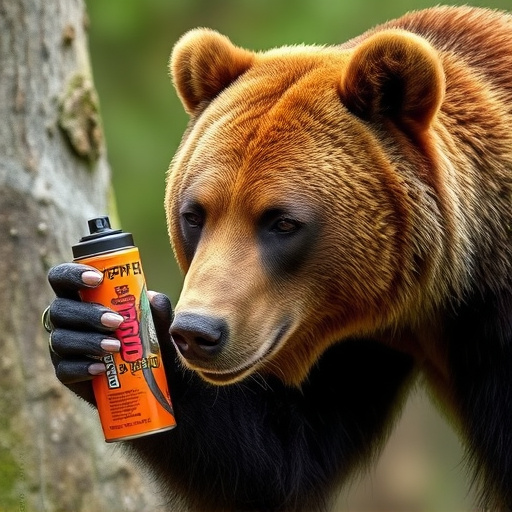Bear spray (pepper spray) is a powerful defense against bears and wild animals, using capsicum to irritate eyes and respiratory systems for temporary protection. Effectiveness varies by weather, proximity, and spray concentration, lasting up to 4-5 seconds in ideal conditions. Proper usage targets the eyes and respiratory areas, while residual irritation can last up to an hour. Storage conditions impact potency, with optimal storage preserving effectiveness up to 3 years. Responsible disposal is crucial to protect wildlife and environment, following local guidelines for used cans.
In the vast wilderness, encountering a bear can be an exhilarating yet potentially dangerous experience. Bear spray, a crucial component of wilderness safety gear, offers a non-lethal means of deterring aggressive bears. This article delves into the science behind bear spray, exploring its effectiveness and the longevity of its impact. We dissect the mechanisms of pepper spray contamination, provide insights on product duration, and offer essential safety guidelines for usage and disposal.
- Understanding Bear Spray: What It Is and How It Works
- The Science Behind Pepper Spray Contamination
- How Long Does Bear Spray Remain Effective?
- Safety Precautions and Disposal Methods for Used Bear Spray
Understanding Bear Spray: What It Is and How It Works
Bear spray, also known as pepper spray, is a powerful personal defense tool designed to deter and incapacitate bears during encounters in the wilderness. It’s not just for bears; this spray can be effective against other large wild animals like cougars and coyotes. Bear spray uses capsicum, an active ingredient derived from chili peppers, which irritates the eyes and respiratory system of the target animal. This irritation causes temporary blindness, coughing, difficulty breathing, and in extreme cases, even temporary paralysis.
The effectiveness and duration of bear spray depend on several factors, including weather conditions, proximity to the target, and the spray’s concentration. In ideal conditions, a single blast from bear spray can provide protection for up to 20 feet (around 6 meters) and last for about 4-5 seconds. However, in harsh conditions like high winds or wet environments, the range and duration may be reduced significantly, with some estimates suggesting as little as 3-7 seconds of effectiveness under adverse weather. It’s crucial to remember that proper usage techniques are just as important as understanding how long it contaminates; aiming for the eyes and respiratory areas offers the best chance of a successful deterrence.
The Science Behind Pepper Spray Contamination
The effectiveness of bear spray, a popular wilderness safety gear, relies heavily on understanding its active ingredient—pepper spray contamination. When used correctly, it creates an irritant mist that temporarily incapacitates bears, providing crucial time for escape or assistance. However, the duration and extent of pepper spray’s impact are complex subjects.
Research suggests that pepper spray remains effective for several minutes, typically ranging from 20 to 45 seconds, depending on various factors like the amount sprayed, wind conditions, and bear behavior. Beyond this initial period, the spray can still cause residual irritation and coughing fits, which could persist for longer periods, up to an hour or more. It’s essential to remember that how long pepper spray contaminates a bear’s senses isn’t just about the active ingredient but also the complexity of its interactions with the animal’s physiology.
How Long Does Bear Spray Remain Effective?
Bear spray, also known as pepper spray, is a popular self-defense tool for outdoor enthusiasts navigating wild spaces. One common question users have is, “How long does bear spray remain effective?” The potency and duration of bear spray depend on several factors. Typically, high-quality bear sprays can maintain their effectiveness for up to 3 years when stored properly. However, this timeline isn’t set in stone; proper storage conditions play a significant role. Extreme temperatures, direct sunlight, or leaving the spray exposed to moisture can degrade its potency faster.
The active ingredient in bear spray—capric acid—works by irritating the eyes and respiratory system of potential threats. When used correctly, even a brief moment of contact should disable an attacking bear. That said, it’s crucial to remember that no pepper spray guarantees 100% protection. Users should always remain vigilant, follow safety guidelines, and consider other precautions like making noise while hiking or camping in bear country.
Safety Precautions and Disposal Methods for Used Bear Spray
When using bear spray, safety precautions are paramount. Always read and follow the manufacturer’s instructions for proper usage. Keep in mind that bear spray is a potent irritant designed to disable, not kill. It can remain effective for up to 5 years if stored properly, but its potency decreases over time. Discard used cans responsibly by following local guidelines. In many areas, it’s recommended to return unused portions or entire cans to retailers for proper disposal, as discarded bear spray can contaminate water sources and harm wildlife if not handled correctly.
To understand how long pepper spray contaminates, consider that its active ingredient, capsaicin, remains potent but can degrade due to exposure to heat, sunlight, and air over time. Used bear spray should never be left in open containers or disposed of in regular trash. Local parks and wilderness areas often have specific drop-off points for used cans, ensuring they are safely contained and disposed of, minimizing environmental impact. Remember, responsible disposal is crucial for maintaining the safety of both humans and wildlife.
Bear spray is a valuable tool for wilderness safety, but understanding its effectiveness and proper usage is essential. While it can deter aggressive bears, the duration of its impact varies. Knowing how long pepper spray contaminates the environment is crucial for responsible disposal. After use, promptly dispose of cans in designated trash receptacles to prevent accidental exposure and maintain the safety of ecosystems. Always follow safety precautions and local regulations to ensure a positive outdoor experience.
